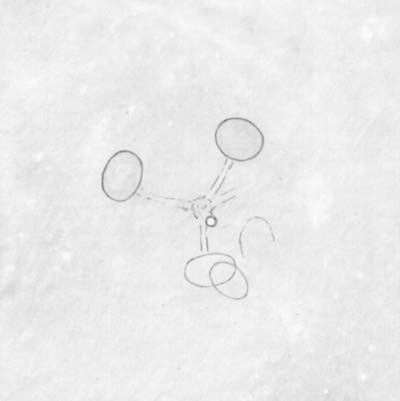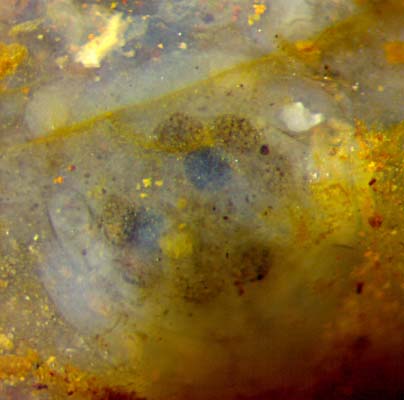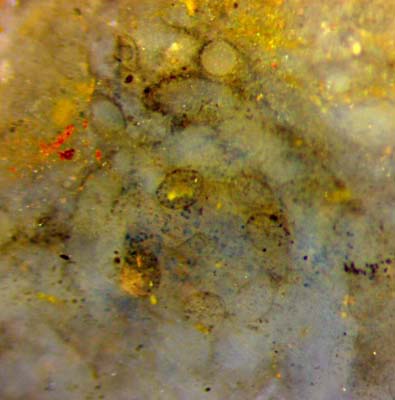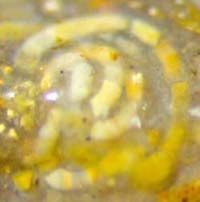A Devonian alga with peculiar features
(Part 3)
When
the unknown alga first described under this headline was found in
another Rhynie chert sample, then described in
Part 2, the suspicion arose that
it is not extremely rare but, when there, nearly always overlooked.
This immediately
raised the question why this intriguing fossil could have been
overlooked. Now a small
chert sample of 30g can
provide a possible answer.
(By the way, a curious but irrelevant coincidence
may be mentioned here: The sample had been found one day before the Rhynie
Chert Conference 2003, where detailed work [1] on Palaeonitella
was presented. The sample was registered and shelved as of no major
interest until it became highly interesting by another investigation a
few days ago, at the end of 2015.)
With the recently discovered
"alga flowers"
in mind, one can see relevant details not seen before on the surface of
this sample. The sterile parts are liable to be
taken for
Palaeonitella
[1], and the fertile parts are rather rare, and when present,
not well preserved so that the enigmatic capsules are easily mistaken
for the ubiqitous globular fungus organs scattered
among plant matter in the chert.

 The
dark
objects in Fig.1, for
example, are likely to
be mistaken for randomly distributed
chlamydospores but they are not mutually unrelated, which becomes
apparent
by thorough inspection only. The yellow stick below one of the
objects gives a clue. One can guess that a faint streak attached
to the other object is another stick or stalk. The two of them point to
a common centre. If there is a centre, it can be an aid to see more:
Another yellow stalk connects the centre with a yellow object similar
to the dark ones, dimly seen in the depth. A bright yellow dot is the
cross-section of a stalk
pointing towards the observer. Mere
pale shadows are left of another two rounded objects below right.
The
dark
objects in Fig.1, for
example, are likely to
be mistaken for randomly distributed
chlamydospores but they are not mutually unrelated, which becomes
apparent
by thorough inspection only. The yellow stick below one of the
objects gives a clue. One can guess that a faint streak attached
to the other object is another stick or stalk. The two of them point to
a common centre. If there is a centre, it can be an aid to see more:
Another yellow stalk connects the centre with a yellow object similar
to the dark ones, dimly seen in the depth. A bright yellow dot is the
cross-section of a stalk
pointing towards the observer. Mere
pale shadows are left of another two rounded objects below right.
Figs.1,2: Two capsules whose mutual correlation reveals their
nature as parts of an "alga flower". Width of all pictures 1mm.
After it has become obvious from Fig.1 that there is a "flowering alga"
in the sample, it is less difficult to see more "flowers" even if they
do not stand out clearly among the numerous sections of alga branches
of various orientation.
Enhanced contrast and sharpened outlines did not much contribute to the
visibility of the relevant details in Figs.3,4. A decaying enclosure
with 5 or 6 capsules inside, one of them with sharp outline, can be
discerned in Fig.3. The outline is faded on the 8 or more capsules in
Fig.4. It is not known whether the
vanishing capsule wall and the
dots inside are something essential in the life cycle or merely the
result of
general decay.

Fig.3: "Alga flower" with capsules likely to be mistaken for branch sections, surrounded by curved branches in
a state of partial decay.
Fig.4: "Alga flower" with
poorly preserved capsules arranged around a very faintly seen columella, all in
a basket made of curved branches.
With
superficial inspection the elliptical spots in Fig.4 with black dots
inside might not be recognized as something special but one detail
provides the proof that what is
seen in Fig.4 is an "alga flower": In order to locate it in this confusing
picture, one may start
from the elliptical spot above right. A long slender stalk,
very faintly seen, extends from there towards below left, crossing the
dark spot in the background and ending above the pale yellow spot,
where it meets 4 stalks from other directions at
a common point.
Only very short parts are seen of the latter stalks so that the centre
looks like a small non-conspicuous "star". It is the tip of the
columella where the stalks are attached.
To
sum up, the above figures have confirmed the suspicion that the
peculiar alga details can easily be overlooked for various reasons. As
a disturbing fact, thorough inspection does not seem to have
removed the
problems and discrepancies with the fossil charophyte algae preserved
in the Rhynie chert.
(1) Apparently
the "alga flowers" described in the present contributions have not been
described elsewhere.
(2) The "alga flowers"
are formed as a basket or cup made of branches which can be either
wound (present sample, Fig.4)
or only curved inward (Rhynie
Chert News 73).
(3) Sterile whorls with spirally wound branches
in the present sample (Fig.5)
resemble similar
structures assigned to Palaeonitella
in Rhynie
Chert News 10.
They do not appear in the
reconstruction of Palaeonitella in
[1].
(4) If the capsules on stalks seen in the "alga
flowers" turn out to be oogonia, the alga described here differs much
from Palaeonitella in
[1]
and from any other charophyte alga
with
their gyrogonites.

Fig.5: Basket made of wound alga branches, seen from below. Width of
the picture 1mm.
It
is hoped that the search for more of the seemingly
incompatible
details of Devonian charophyte algae will finally lead to a
consistent view.
Sample found in 2003, fossil seen in 2015.
Addendum: After correcting the scale in [2], Fig.3.56, by a factor
of 10 or more, it becomes apparent that the danger of mistaking alga
capsules for fungus chlamydospores is not only due to the similarity of
shapes and sizes. The clusters of alga capsules with stalks might be
mistaken for Sclerocystis chlamydospores on hypha ends.
H.-J.
Weiss
2016
[1] R.
Kelman, M. Feist, N.H. Trewin, H. Hass :
Charophyte algae from the Rhynie chert,
Trans. Roy. Soc. Edinburgh, Earth
Sciences 94(2004 for 2003), 445-455.
[2] T.N. Taylor et al.: Paleobotany (2009).
 |
 |
90 |



 The
dark
objects in Fig.1, for
example, are likely to
be mistaken for randomly distributed
chlamydospores but they are not mutually unrelated, which becomes
apparent
by thorough inspection only. The yellow stick below one of the
objects gives a clue. One can guess that a faint streak attached
to the other object is another stick or stalk. The two of them point to
a common centre. If there is a centre, it can be an aid to see more:
Another yellow stalk connects the centre with a yellow object similar
to the dark ones, dimly seen in the depth. A bright yellow dot is the
cross-section of a stalk
pointing towards the observer. Mere
pale shadows are left of another two rounded objects below right.
The
dark
objects in Fig.1, for
example, are likely to
be mistaken for randomly distributed
chlamydospores but they are not mutually unrelated, which becomes
apparent
by thorough inspection only. The yellow stick below one of the
objects gives a clue. One can guess that a faint streak attached
to the other object is another stick or stalk. The two of them point to
a common centre. If there is a centre, it can be an aid to see more:
Another yellow stalk connects the centre with a yellow object similar
to the dark ones, dimly seen in the depth. A bright yellow dot is the
cross-section of a stalk
pointing towards the observer. Mere
pale shadows are left of another two rounded objects below right. 



